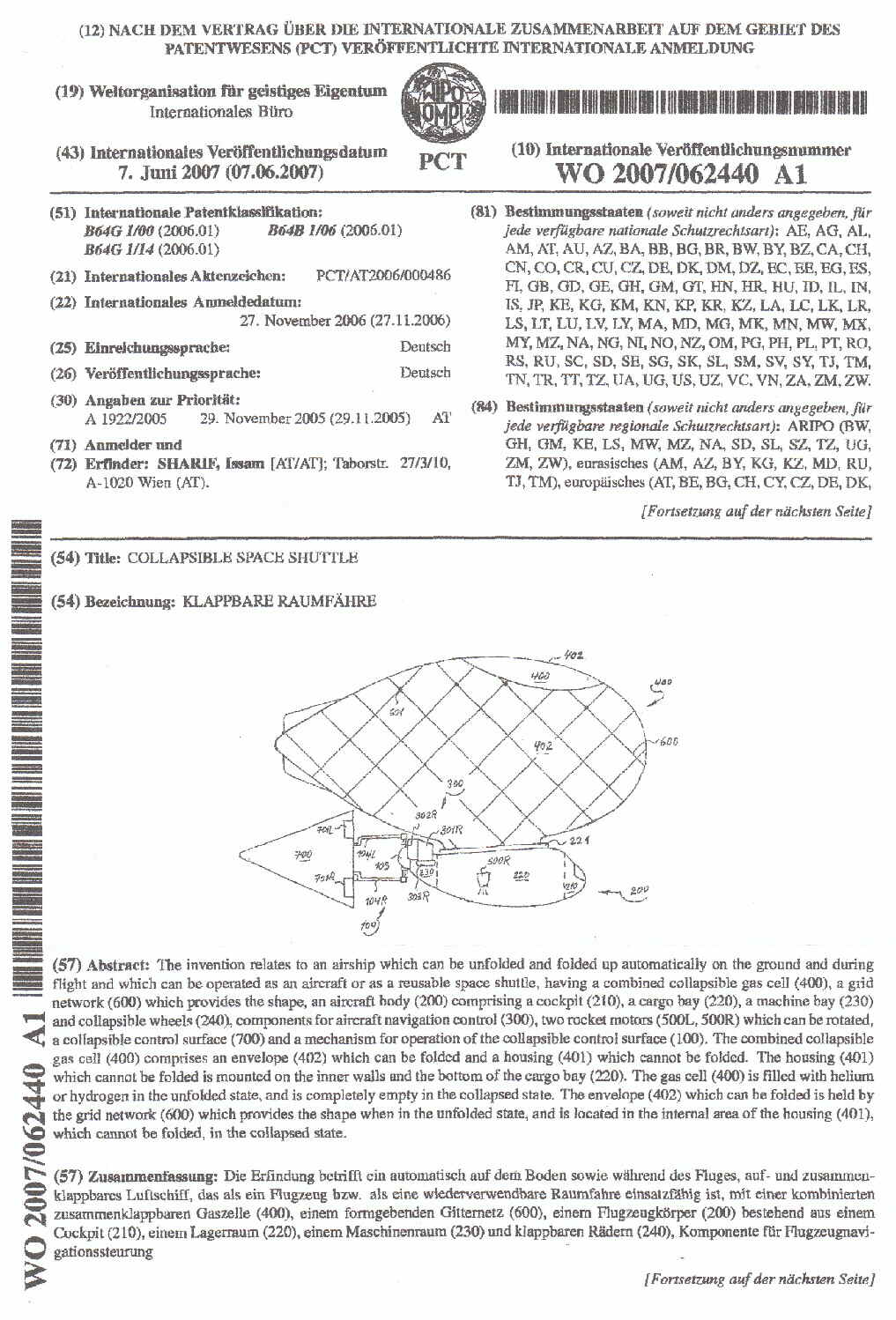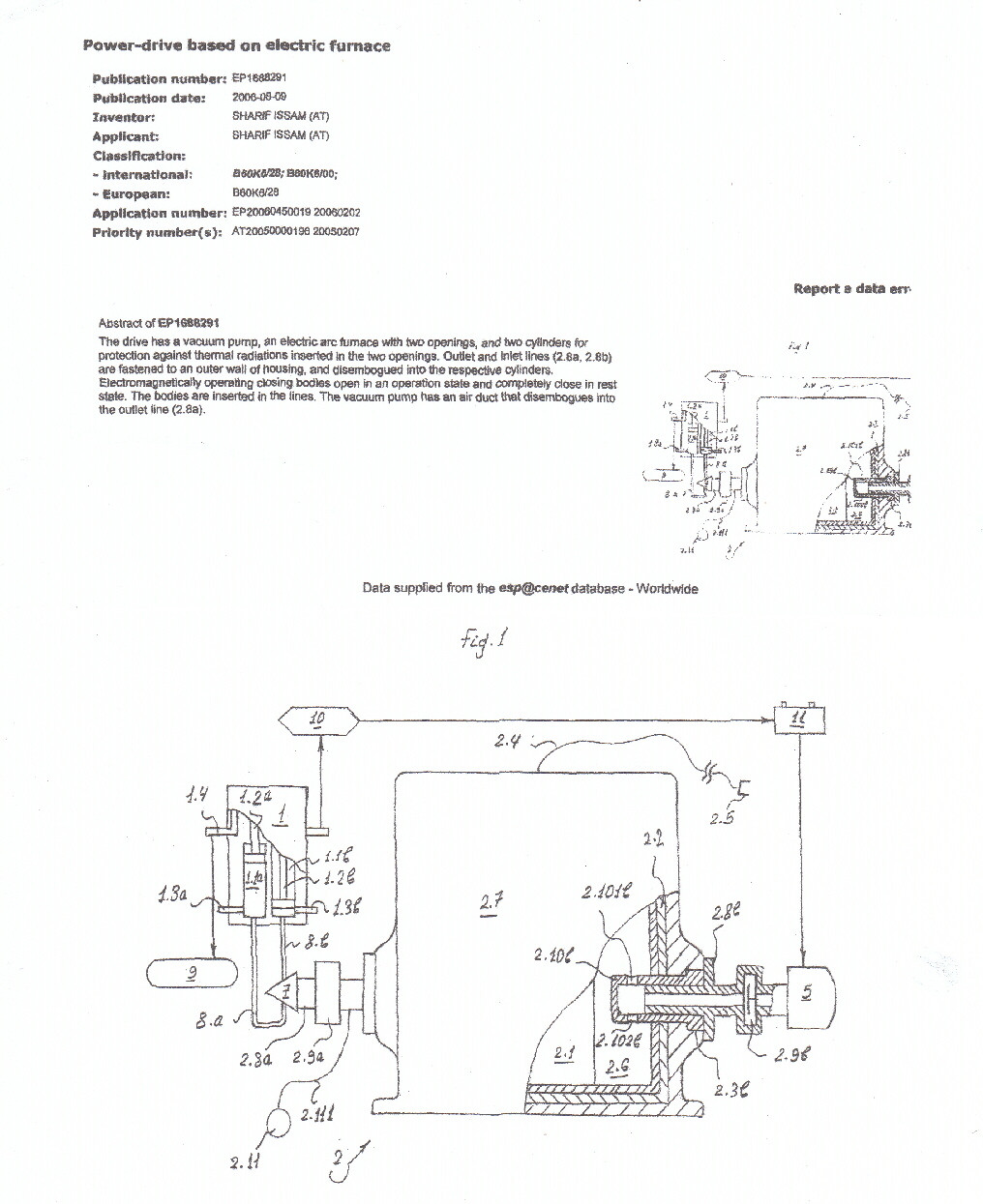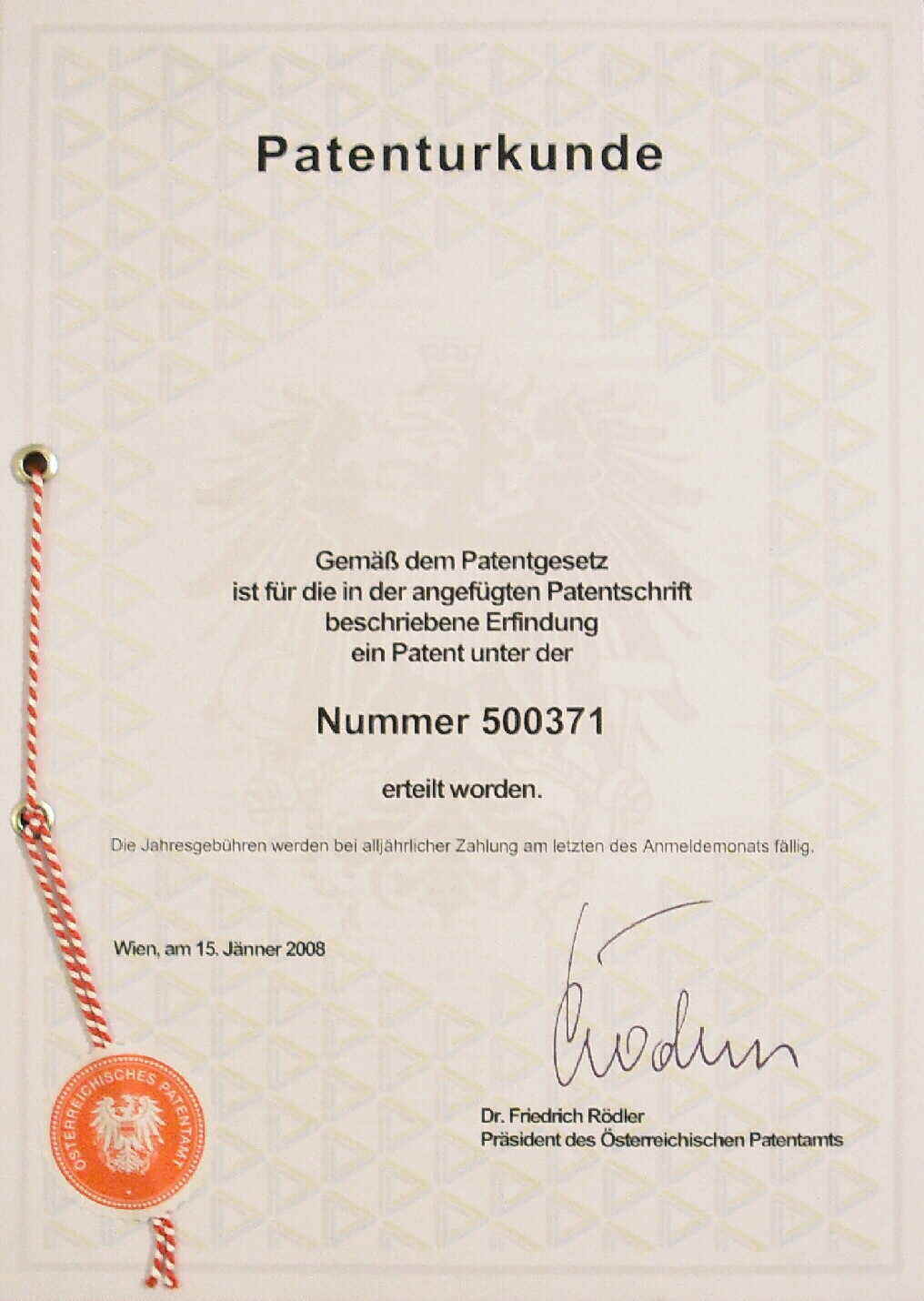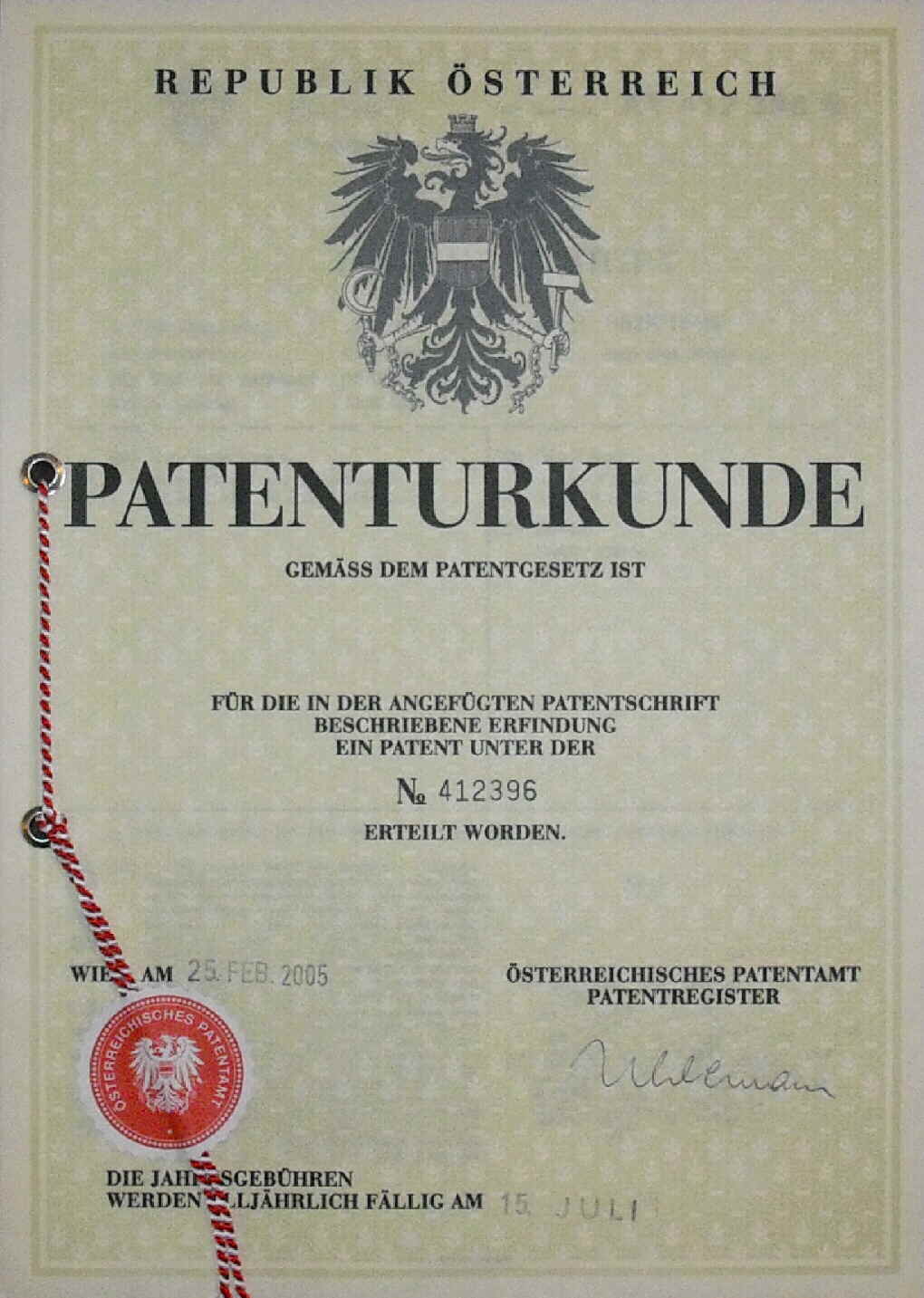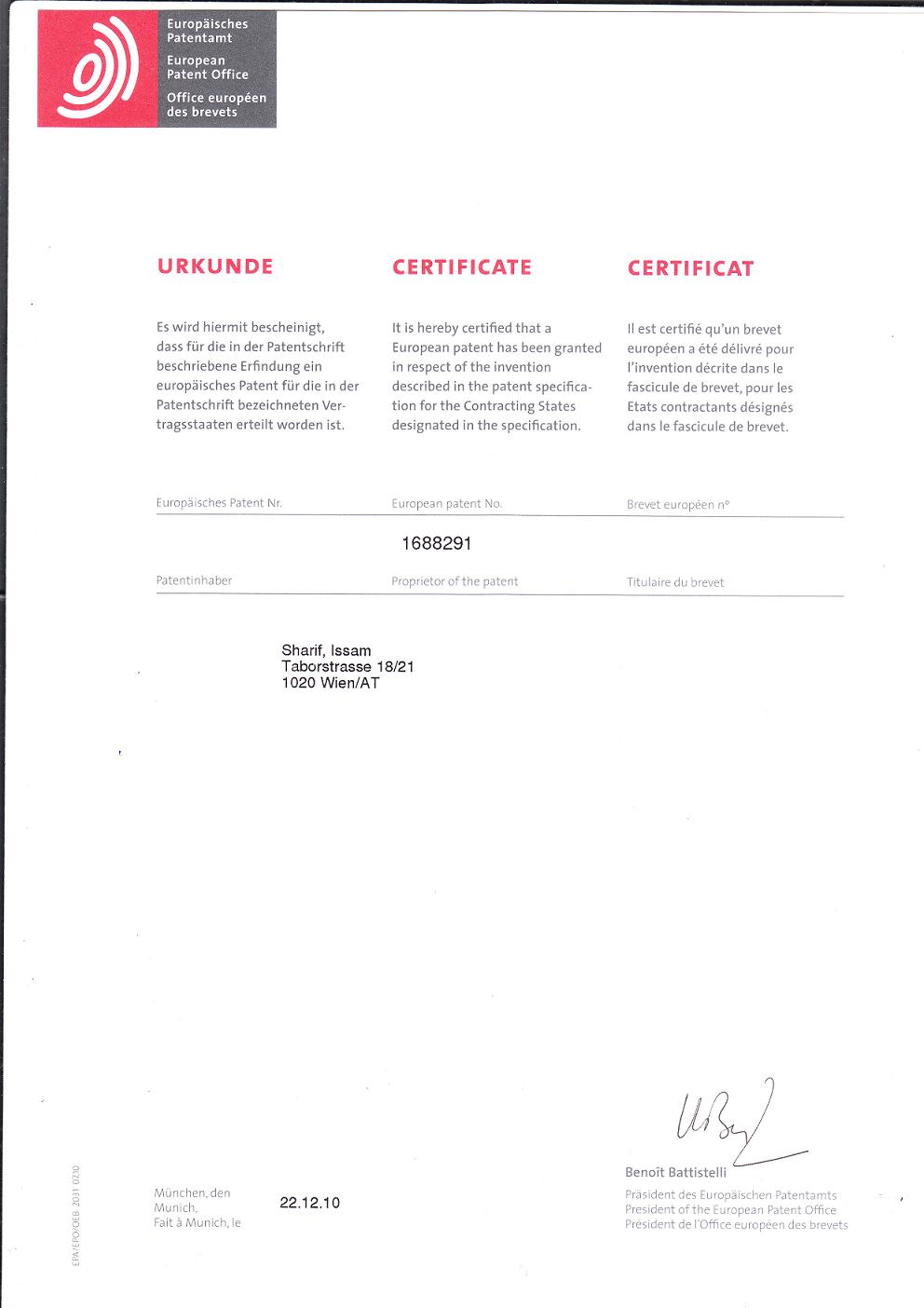
Sharif is an owner of a number of inventions, three of which are major breakthroughs. These three inventions are described below.
Sharif ist Inhaber einer Vielzahl von Erfindungen, drei davon sind bedeutende Durchbrüche. Auf diese drei Erfindungen wird weiter unten genauer eingegangen.
شريف صاحب عدد من الاختراعات. ثلاثة منها احدث اختراق هام في المعرفة التقنية. وفي ادناه وصف لهذه الاختراعات.
Sharif Hydropower Technology

A patent application for this invention
has been filed with the
European Patent Office
under the application number:
EP15150543.5 - 1610
and the title
Rigid body dynamics-based hydropower technology
A relatively small investment in the present technology would allow for the generation of almost free of charge electricity on a permanent basis and through its worldwide use, our planet would be virtually carbon-free after the period needed to build the related hydropower plants and convert diesel and gasoline vehicles into electricity and hydrogen.
has been filed with the
European Patent Office
under the application number:
EP15150543.5 - 1610
and the title
Rigid body dynamics-based hydropower technology
Where the Inventive Efforts in the Field of Renewable Energy should be directed
If we conduct a simple survey on the State-of-the-Art Technologies for renewable energy, we will notice that renewable energy inventions and innovations are mainly confined to wind and solar energy, and it is generally believed that the use of these energy sources will save the planet from being destroyed by global warming.
In wind and solar energy we have two disadvantages compared to renewable water sources. The first is the problem of inherent variability. On one day there is sunshine and strong wind, while on the other rain and no wind. The second is they do not contain massive energy. In the case of wind energy, for example, we face the problem is the low air density. At sea level, air is 784 times less dense than water. This is the cause for relatively high investment requirement per unit output. Solar panels are very useful for small households or for installation on car roofs, but not as an economically viable alternative to large scale plants that use fossil fuels.
Solar and wind energy are quite expensive and, with a few exceptions, can only be used with subsidies and never to play a decisive role in replacing fossil fuels and combat global warming.
The potential energy that saves the planet from destruction is to be found in water renewable sources. As mentioned earlier, these sources contain potential energy that exceeds the total global energy requirement by thousands of times. An interesting example of the vast amount of potential energy naturally given to humankind is the Niagara Falls. Six million cubic feet of water flow over Niagara Falls every minute. How much investment would it take to produce as much energy from fossil fuels and how much pollution will be caused? Despite their abundance, the total output of hydropower stations currently accounts only about 16% of global electricity generation. The greatest amount of electrical energy comes from steam turbines coupled to electric generator driven by steam produced either in a fossil-fueled fired or nuclear-powered generator.
The Phenomenon of Worldwide Stagnation of Hydropower Production and its causes
As we have seen the solution for generating large amounts of low-cost energy and curbing global warming can only be found in renewable water sources. But first and foremost, we must discover what is wrong with the conventional hydropower technologies.
The EU statistics for 2013 show that the share of electricity generated from renewable energy sources in total electricity production in Austria were 68.1%. This was the highest in the EU and higher than Sweden (61.8%). Despite this impressive performance, Austria is partly dependent on imported oil, gas and electricity generated from fossil energy sources.
From the following diagram two facts could be established. The first is, despite the fact that Austria is an ideal hydropower country; renewable energy generation growth was achieved through the expansion of biogenic fuels, shown in orange. The second fact is that the Austrian hydropower shown in blue has stagnated since the end of the 1990s.


There is not a single hydropower technology which is capable of efficiently harnessing a low-head renewable water source like the one shown in the figure below. As indicated earlier these abandoned sources represent the vast majority of renewable water sources worldwide and contain potential energy that exceeds the world's energy needs by thousands of times.

What is the cause for the inability of the traditional hydropower technologies to generate mechanical energy from low-head renewable water sources? Despite the diversity of traditional hydropower plants, all have one feature in common. They extract the kinetic energy of the flowing water through spinning devices, such as turbine and water wheel. By rotating these devices mechanical power is generated. This means that the working principle of all conventional hydropower technologies is based on the physical laws of fluid mechanics.

The mechanical efficiency and economic feasibility of the turbines depend on the heights of hydraulic heads. The Water flowing from low hydraulic heads passes through the blades without being able to turn the turbine. With a couple of exceptions, basing the hydropower technology on the physical lows of fluid mechanics, which are dependent upon high heads, is the cause for abandoning of the bulk of renewable water sources. Since these sources have low heads and insufficient flow, high dams have been constructed to enable creating high heads which guarantee the efficient use of the turbines.

But constructing high dams causes huge ecological and economic damages. Despite the ecological and economic damages they cost, these dams harness only a small share of the world wide available renewable water sources. The question is why no appropriate technologies for harnessing the huge renewable low-head water resources have been developed? Restricting the research curried out by universities and producers of hydropower devices on developing devices functioning on the basis of the laws of fluid mechanics is the cause why no appropriate technologies for harnessing the renewable low-head water sources have been developed.
Solving the Problem of Inability to Efficiently Generate Mechanical Energy from low-head Water Sources
Readers who are not interested in the technical aspects of the invention may ignore this part and proceed to the "Demonstration of the Functioning Principle of the Invented Technology" section.
Now that the cause for why we must rely on fossil fuels was diagnosed, we need to invent a suitable technology which allows the use of low-head water sources. The present inventor realized that such an invention requires finding an appropriate sequence of energy conversions to allow extracting the potential energy contained in low-head water sources and converting it into kinetic energy. His research began by trying to get some inspiration from various processes of transforming the potential energy found in fossil fuels into kinetic energy. In the case of external combustion engine, for example, the potential energy contained in coal is transferred by combustion into thermal energy, which converts into kinetic energy contained in the steam. Finally, by pushing the piston by the steam, the kinetic energy is converted into mechanical energy.

Water is a medium in the case of steam engine. We also need to transfer the potential energy contained in low-head water sources to a suitable medium. But what medium might be appropriate to absorb the potential energy in the water. This medium must also be able to convert the absorbed potential energy into kinetic energy? The first discovery was the need to use a rigid body as a medium to allow the conversion of the absorbed potential energy into mechanical energy on the basis of the physical laws of rigid body dynamics. This led to the idea of building a simple mechanism using a seesaw. On one side a trolley with a load and on the other an empty container. The weight of the container filled with water should be a little higher than that of the trolley with a load. Before pouring water into the container, the trolley with a load contains zero potential energy.

Once the container is filled with water the right side of the seesaw would be heavier than the left side and the trolley with a load begins rolling towards the right side. At this moment the potential energy in water is transferred to the trolley with a load.

After rolling at the end of the right side of the seesaw the potential energy contained in the trolley with a load will be converted into kinetic energy. The trolley with a load is a medium like the water in steam engine.

A significant step towards discovering how to transfer the contained energy in low-head water source was imitating the work of the internal combustion engine. A vessel with water intake and outflow gates was used as a cylinder. A float with extension used as a piston. On top of the extension the trolley with a load is placed.

As shown in the figures (a) and (b) above, we have a chamber with a base area of 1 m2 and a depth of 3 m in the ground and a float larger than 1 m3 with extension is placed inside the chamber. According to Archimedes' principle on "Floating Bodies" the weight of the trolley with a load must be equal to the weight of the fluid it displaces by the float. We need 2 m3 of water to raise the trolley with a load weighing one ton over a height of 2 m. The figure (a) shows that by opening the intake gate and closing the outlet gate the water would flow into the vessel, pushing the float upwards along with the trolley with a load. The figure (b) shows that the trolley with a load has now gained the potential energy which was contained in water and can now be used for generating kinetic energy. In order to repeat the cycle, the vessel must be emptied to allow the float with extension after disposing of the trolley with a load to return to the initial position. By opening the outflow gate and closing the intake gate the water would flow out of the vessel and the float would rest on the bottom of the vessel. The working principle of the vessel with the float resembles that of a cylinder and the piston of a combustion engine. As the first is fueled by water the latter is fueled by diesel or petrol. The last obstacle to completing the invention was the problem with the shape of the rigid body. The rigid body in the form of a trolley with a load cannot be used as a medium for operating an engine. The rigid body must have a shape that allows it to absorb the potential energy from the water, convert it into kinetic energy, transfer the kinetic energy to a flywheel to convert it into mechanical energy, and return to the starting position to repeat the production cycle. After months of experimenting with different forms of the load and corresponding mechanisms to find an appropriate solution, the inventor was about to give up work on the invention. But one day, his cousin sent a photo of her daughters standing in front of the replica of the Al-Jazari clock elephant in Dubai.


Al-Jazari was a genius medieval engineer and inventor (1136-1206). The elephant clock was a complicated mechanism powered by weights in the form of metal spheres. The spheres are placed in the upper reservoir. In this position they contain potential energy. Every half hour, a spheres falls into the mouth of a serpent, causing it to tip forward. In this way, the falling sphere transforms the stored potential energy into kinetic energy and then the kinetic energy into mechanical energy. Spheres have been chosen to perform these functions as they can pass through any passage without being stopped or losing energy due to friction. With the idea of the spheres, the invention was completed.
Demonstration of the Functioning Principle of the Invented Technology
After discovering how to generate electricity from any hydraulic height, a number of types of hydropower plants were designed, the most important of which is presented below.

Let us now demonstrate how to generate electricity from a low-head water source. After filling the chamber, the sphere is raised to a higher level corresponding to the hydraulic height. At this level, it embodies the gravitational potential energy, which was previously embodied in the water.

Then the sphere rolls over the slide and settles on the tray. The mass of the sphere pulls the chain hanging around the gear downwards. In this way, the flywheel is rotated and allows the generator to continuously generate electricity. The contained gravitational potential energy in the sphere converts into kinetic energy during the descent. This is exactly like generating kinetic energy by burning the diesel fuel in the cylinder of the diesel engine.

After performing a work, at the ground level the sphere rolls and settles on the tray of the extension. After discharging the water from the chamber the production cycle could simply be repeated by refilling the chamber with water. This is exactly similar to the process of repetition of the cycle of an internal combustion engine.

Economic gains from the use of the invented technology
The production of usable energy by burning fossil fuels is not only the cause of global warming, but also the cause of technical stagnation of the energy sector. Burning fossil fuels to generate useful energy is technologically primitive, expensive and causes high transport, production and living costs. In what follows we will proof that generation of electricity from renewable low-head water source using the invented technology could be thousands of times lower than that using a diesel engine. We will use the figures presented on page 8.

We need 2 m3 of water to raise the trolley with a load weighing one ton over a height of 2 m. If the water is supplied from an appropriate source, the chamber will be filled in one second. If we create a second chamber to allow for filling and emptying in tandem, we can continually raise a load weighing one ton over a height of 2 m every second day and night all year long. Since water is supplied free by nature, the only cost will be the investments requirement to build two tiny chambers and install floats with extension in them. A part of the cost of the diesel engine, in order to continually raise one ton 2 meters high every second day and night all year long, huge amount of diesel is required. The cost difference in per unit performed work must be in thousands. The unit cost of electricity produced by using the invented technology must also be thousands of times lower than that produced from wind or solar energy. How much investment does it take to build wind turbines or solar panels to generate energy to raise one ton to a height of two meters every second day and night all year round? Because of their relatively high investment costs, wind and solar energy must be used in places where no renewable water sources are available In contrast to wind turbines and solar panels, the implementation of the present invention will make fossil fuel extremely expensive and will force them to disappear. The images below compare the investment in physical capital of electricity generation by diesel engines based on (oil) with those by the invented technology based on (renewable water source).

The images above show how complicated and expensive it is to produce useful energy from oil. Locating and drilling of an oil well require relatively large investments. The process before producing diesel begins with the extraction and recovery of crude oil, then transporting of crude oil through pipelines and tankers to refineries. The refined oil would then be transported to the consumers. Refined oil in the form of diesel is then used to power diesel engines to generate mechanical energy and electricity.

Every large river, small streams, creeks, low and high waterfalls, shores with differences of high and low tides, even locations having unseen underground currents are suitable for building hydropower plants using the invented technology. As these water sources contain potential energy that exceeds the global need for electricity thousands of times, there no quantitative limitation for electricity generation. The dispersion of electricity generation capacities would have a positive impact on the national economy, as new sources of economic wealth in areas which have been abandoned or never previously exploited due to lack of electricity can be exploited. With extremely low investments, excessive low-cost electricity can be generated wherever renewable water sources are available. In this way huge economic wealth can be generated and new jobs and businesses can be created.
Uses of the invention
Due to the ability of the invented technology to use low-head water sources, most of the available renewable water sources will be suitable for electricity generation. Farms, schools, hotels, communities and industrial companies who have access to water source can generate their own low-cost power. By constructing small hydropower plants, farmers would have access to free electricity, reduce their production costs and become more competitive.

The creation of a self-sufficient electricity sector would allow for the use electric and hydrogen tractors and other agricultural vehicles. A farm with its own hydropower plant using the invented technology can produce low-cost hydrogen by electrolysis to power hydrogen fuel-cell tractors. The same applies to the use electric engines in tractors and other agricultural vehicles.

The present technology is the only technology that can currently link transportation directly to renewable energy sources to enable the creation of zero-emission transportation. Auto manufacturers can build large-scale hydropower plants using the present invention in suitable locations to produce electricity and hydrogen at low costs for their filling stations. They can sell the electricity generated from their large hydropower plants to the grid and buy electricity from the grid to supply their filling stations. Small-scale Electrolyzes can be placed in the filling stations to produce hydrogen. In this way transportation will be linked directly to renewable water sources.


The construction of large-scale hydropower plants enables companies with high electricity costs to obtain electricity almost free from a relatively low one-time investment. Metallurgical, chemical and mechanical engineering companies can construct their own large hydropower plants in suitable locations for electricity generation, unrelated to the location of their production plants. The electricity generated can be sold to the grid, and at the same time, the electricity needed for the production can be purchased from the grid. In this way production of goods and services will be linked directly to the renewable water sources.

There are a large number of suitable locations for generating electricity in large quantities using the present technology. Small and large rivers with relatively steep slopes and locations of run of the river installations are in principle suitable for large-scale hydropower plants. They can be designed in different ways, using large chambers and gigantic spheres. In order to enable using the whole flowing water in locations of run of the river installations the design must be done on the basis of the principle of integrating a number of chambers into one plant as shown in the figure below.

The water outlet of the highest block would be used as a water intake for the second and the water outflow of the second would be used as water intake for the third and so on. In this way using the invented technology can generate the same amount of electricity using conventional technology without building a dam and flood of land.

Instead of creating a high dam hundreds or even thousands of small, medium and big hydropower plants using the invented technology could be built on the above principle. In this way the same generating capacities could be achieved without the construction of dams, flooding of land and causing so much ecological and economic damage.

The governments must not only refrain from constructing new dams but demolish the existing ones.

The environmental impact of using the invented technology
The disadvantages of using fossil fuels are not limited to global warming. The pollution caused by and the extraction and transport of crude oil are frightening. Oil tankers sink causing disasters, crude oil extracting defects cause catastrophic effects. Refineries cause carbon emissions. Finally, burning refined products to generate electricity or mechanical power also causes carbon emissions. It's crazy to produce useful energy from oil in a world full of renewable water sources.
In contrast to fossil fuels' based power generation the invented technology uses free available renewable water.


By constructing tens of thousands of hydropower plants using the invented technology worldwide, the positive impact on environment would be immense as it allows for the closure of the existing electricity generation plants using fossil fuels.

Instead of investing in filters to absorb carbon emissions from burning of fossil fuels, it is much cheaper and ecologically friendlier to investment in new hydropower plants using the invented technology and scrap fossil fuels facilities. Low-cost electricity generated from renewable water sources can replace fossil fuel in metallurgical and chemical industries. An interesting example in this connection is the production of pig iron in electric arc furnace instead of blast furnaces using coal. As is known waste gases from blast furnace has relatively high carbon content. Thus, the production of clean energy at low cost would make the use of the electric arc furnace cheaper and would have a positive impact on the environment without the need to install expensive filters by keeping the polluting obsolete technology.

By implementing the invented technology the entire fossil fuel industries and allied industries, from extraction to energy generation will become history. And with their disappearance, the world would be free of their pollutions and their carbon emissions.

Time is running out and we should not wait until the Arctic is completely melted. Global warming can only be stopped by building hydropower plants using cost-effective technologies to replace fossil fuels with renewable energies.

Collapsable Space Shuttle
This invention was patented by the European Patent Office.
For a full description of the invention refer to the following links:
www.espacenet.com
The idea of the invention "Collapsible Space Shuttle", which is a major technical break through, was initially developed as a reaction
to the experimental spaceplane SpaceShipOne, the winner of the Ansari X PRIZE. This space shuttle accomplishes a sub-orbital journey by means of a carrier
and carried flying machines. This makes its fabrication and operation extremely expensive.
In contrast to this, the task of the invention "Collapsible Space Shuttle" was to create an airship which is capable of accomplishing the entire take-off in the earth's atmosphere by means
of a static lift and of flying beyond into the space by means of a dynamic lift. Such a sub-orbital space shuttle can as a result of fuel conservation replace a carrier and a carried flying
machines and, thereby, realizing enormous savings in the fixed and variable costs. Taking-off in the earth's atmosphere by means of a static lift is safer and enables also the avoidance of a
number of technical complications, such as the dependency on special airports or on launching pads for taking-off and on parachutes for landing in addition to other shortcomings during take-off,
such as noise and pollution caused by emissions.
The collapsible space shuttle can be unfolded and folded up automatically on the ground and during flight and can be operated as an aircraft or as an airship. The collapsible space shuttle in
the configuration of an aircraft can accomplish the take-off by means of a static lift and then fold up and flay horizontally as heavier than air flaying machine like traditional aircrafts. It
can unfold short before reaching the target destination and touch down in the configuration of an airship.
In the configuration of an air ship the collapsible space shuttle can substitute a helicopter. It can hover for ours and ours by means of a static force without wasting a drop of fuel.
Power Drive based on Electric Furnace
Patented by the European Patent office under the number EP 1688291. For a full description of the invention refer to the following link:
The invention "Power-Drive based on Electric Furnace" is also a major technical brake through. This invention provides a solution for the problem of the limited capacities of electric batteries required to drive different means of transportation. For example it is not feasible to use thousands of batteries to power a ship. An electric furnace filled with heat resistance steel enables the conversion of huge quantities of electric current into heat. The heat could be preserved in the electric furnace. By demand the heat could be converted into mechanical power by means of pumping of air or water into the electric furnace from one opening and attaching a motor unit to the second opening. The heated air or vapor generates high pressure which would drive the motor. A ship of a capacity of 300.000 tons would, for example, be able to accommodate an electric furnace filled with 30.000 tons of steel without a problem. A power-drive based on this electric furnace would also be able to power such a ship without a problem. A power - drive based on electric furnace can also be applied for powering aircrafts using hydrogen as fuel. By injecting the compressed hydrogen together with air into the furnace it would burn without the need for carrying compressed oxygen on board. In this way the aircraft would be liberated from carrying on board the heavy tanks of compressed oxygen and in the same time would partially replace fuel by means of electric power. Less fuel means in turn weight reduction. This invention provides also a solution for the problem of the limited capacities of electric batteries required for powering motor vehicles and the length of time required for their recharging. The "Power-Drive based on Electric Furnace" can power motor vehicles by means of heated air.
